Today is all about the ECB. The press claims to have access to people or documents that have the ECB buying 50 bln euros of bonds a month. The duration of the program is not clear. There was a conflict in the media. Some claimed that the program would last a year. Others claimed it would last until the end of 2016.  Â

Aside from duration, other key elements of the program were apparently not leaked. These include the pooling of risk.  Specifically, are the bonds kept on the ECB’s balance sheet or the national central banks. Creditors and debtors are aligned on different sides of the issues. Also, what instruments can be bought? Should bonds with a negative yield be purchased?  What about bonds below investment grade?  What are the maturity guidelines?  Â
The point is that there are many moving parts, and there is plenty of scope for surprises.  There is some speculation that the ECB could push its deposit rate more into negative territory, and/or cut the 30 bp emergency lending rate. The focus has been almost exclusively on sovereign bonds, but what of the EU and EIB bonds?  We had suggested foreign bonds (US Treasuries), but Draghi dismissed this as too much like intervention. Â
The technical and operational requirements are substantial.  It will likely take several weeks to set it up.  A March start date would not be surprising, and at least one of the leaks suggested as much. Between early December when ECB signaled it would do take more actions to expand its balance sheet to the time the first bonds are bought, the Bank of Japan would have expanded its balance sheet by roughly 4% of GDP or around $200 bln. This would be the equivalent of the ECB expanding its balance sheet by about 450 bln euros. Â
Leaving aside the precise details, including size, we are not persuaded that increasing the ECB balance sheet will boost CPI. It does not appear have worked by this measure. This is clearly true in Japan, where the BOJ cut revised down its CPI forecast.  Without flogging a dead horse, suffice it is here to simply say that base money rises under QE, but not money supply. The decline in the euro and the decline in oil are net positive developments for the eurozone. Core inflation remains positive.  Bank lending to households and businesses is improving gradually. It seems more a demand than a supply problem. Â

